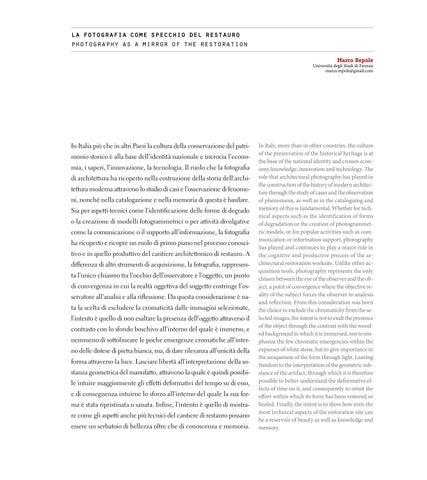la fotografia come specchio del restauro photography as a mirror of the restoration Marco Repole
Università degli Studi di Firenze marco.repole@gmail.com
In Italia più che in altri Paesi la cultura della conservazione del patrimonio storico è alla base dell’identità nazionale e incrocia l’economia, i saperi, l’innovazione, la tecnologia. Il ruolo che la fotografia di architettura ha ricoperto nella costruzione della storia dell'architettura moderna attraverso lo studio di casi e l'osservazione di fenomeni, nonché nella catalogazione e nella memoria di questa è basilare. Sia per aspetti tecnici come l’identificazione delle forme di degrado o la creazione di modelli fotogrammetrici o per attività divulgative come la comunicazione o il supporto all’informazione, la fotografia ha ricoperto e ricopre un ruolo di primo piano nel processo conoscitivo e in quello produttivo del cantiere architettonico di restauro. A differenza di altri strumenti di acquisizione, la fotografia, rappresenta l’unico chiasmo tra l’occhio dell’osservatore e l’oggetto, un punto di convergenza in cui la realtà oggettiva del soggetto costringe l’osservatore all’analisi e alla riflessione. Da questa considerazione è nata la scelta di escludere la cromaticità dalle immagini selezionate, l’intento è quello di non esaltare la presenza dell’oggetto attraverso il contrasto con lo sfondo boschivo all’interno del quale è immerso, e nemmeno di sottolineare le poche emergenze cromatiche all’interno delle distese di pietra bianca, ma, di dare rilevanza all’unicità della forma attraverso la luce. Lasciare libertà all’interpretazione della sostanza geometrica del manufatto, attraverso la quale è quindi possibile intuire maggiormente gli effetti deformativi del tempo su di esso, e di conseguenza intuirne lo sforzo all’interno del quale la sua forma è stata ripristinata o sanata. Infine, l’intento è quello di mostrare come gli aspetti anche più tecnici del cantiere di restauro possano essere un serbatoio di bellezza oltre che di conoscenza e memoria.
In Italy, more than in other countries, the culture of the preservation of the historical heritage is at the base of the national identity and crosses economy, knowledge, innovation and technology. The role that architectural photography has played in the construction of the history of modern architecture through the study of cases and the observation of phenomena, as well as in the cataloguing and memory of this is fundamental. Whether for technical aspects such as the identification of forms of degradation or the creation of photogrammetric models, or for popular activities such as communication or information support, photography has played and continues to play a major role in the cognitive and productive process of the architectural restoration worksite. Unlike other acquisition tools, photography represents the only chiasm between the eye of the observer and the object, a point of convergence where the objective reality of the subject forces the observer to analysis and reflection. From this consideration was born the choice to exclude the chromaticity from the selected images, the intent is not to exalt the presence of the object through the contrast with the wooded background in which it is immersed, nor to emphasize the few chromatic emergencies within the expanses of white stone, but to give importance to the uniqueness of the form through light. Leaving freedom to the interpretation of the geometric substance of the artifact, through which it is therefore possible to better understand the deformative effects of time on it, and consequently to intuit the effort within which its form has been restored or healed. Finally, the intent is to show how even the most technical aspects of the restoration site can be a reservoir of beauty as well as knowledge and memory.
